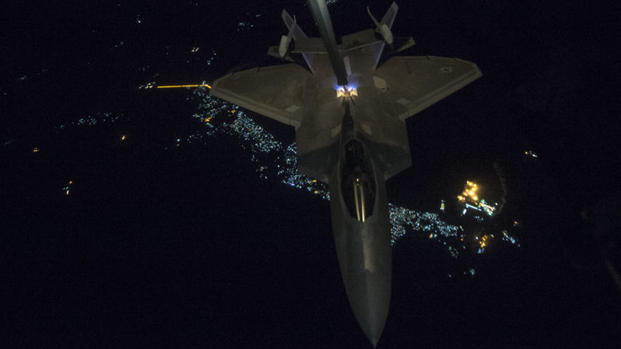The Air Force has unleashed the F-22 Raptor stealth fighter in Afghanistan for its first operational mission against Taliban drug labs, the Defense Department said Monday.
The F-22s were joined by B-52 Stratofortresses and Afghan A-29 Super Tucanos to conduct an expanded strike mission -- called the new offensive campaign -- against the Taliban's revenue stream, said Army Gen. John Nicholson, commander of the NATO-led Resolute Support mission and U.S. Forces Afghanistan.
The Raptor "was used because of its ability to deliver precision munitions -- in this case, a 250-pound bomb, small-diameter, that causes the minimal amount of collateral damage," he said during a teleconference briefing in Kabul.
"This target was also a Taliban narcotics production facility in Musa Qala. So I want to draw your attention -- as you look at this strike, you're going to see that inside this compound are multiple structures, and we destroy only two of them, while leaving the third standing, which we do to avoid collateral damage," Nicholson said.
Related content:
- Why the F-22 Raptor Didn't Get the Air-to-Air Kill in Syria
- The F-22 in Syria: Deconflicting, Not Dog-Fighting
- Did the Air Force Dash Hopes for Building More F-22s?
The F-22s launched from Al Dhafra Air Base, United Arab Emirates, where the stealthy, fifth-generation jets reside for operations in the Middle East. The Raptors are part of the 95th Expeditionary Fighter Squadron out of Tyndall Air Force Base, Florida.
The mission was aided by "refueling support from KC-10s and KC-135s, ISR platforms and command and control aircraft," said Lt. Col Damien Pickart, Air Forces Central Command spokesman.
"Along with Air Force assets, our joint partners contributed to the fight with strike support from U.S. Marine Corps High-Mobility Rocket Systems (HIMARS), and ISR capabilities from U.S. Army assets," Pickart said in a statement.
Nicholson said using a variety of aircraft together provided a larger range of bombs necessary for the mission.
"We're looking for a mixture of ordnance in the air over the targets so that, as we make the final decision on the use of which weapon, based on concerns about collateral damage, we needed to have a variety of airframes available with different kinds of munitions," he said.
"And so that was the purpose [of the F-22]. It wasn't because of some of the other capabilities of that aircraft," he added.
The Raptor has played a crucial yet evolving role in air operations over Syria and Iraq, including its high-value mix of weapons.
The F-22 wields the AIM-9X Sidewinder missile; the AIM-120 Advanced Medium-Range Air-to-Air Missile (AMRAAM); the precision-guided GBU-39 Small Diameter Bomb (SDB); and the GPS-guided GBU-32 Joint Direct Attack Munition (JDAM).
One F-22 pilot who spoke with Military.com in June said the Small Diameter Bomb is more likely to be used, especially in the counter-Islamic State fight in urban areas where the Raptor is conducting precision strikes.
"We carry the low collateral damage weapon, the Small Diameter Bomb GBU-39, to precisely strike enemy combatants while protecting the civilian population," said Lt. Col. "Shell," an F-22 pilot and commander of the 27th Squadron on rotation at Al Dhafra. He spoke to Military.com on the condition that he be identified by his call sign.
"We also can carry the 1,000-pound JDAM GBU-32 used for targets where there is less-to-little collateral damage concern," meaning a larger blast for attack.
Regarding Sunday's bombing run, Nicholson said airstrikes have been and will continue to be on the rise.
For example, the Air Force dropped more than 900 weapons in August and September combined, up from 270 for the same timeframe last year, according to AFCENT's latest airpower summary.
"We've used airpower -- dropped more munitions this year than any year since 2012," Nicholson said.
Check out the video from the new offensive campaign below:
-- Oriana Pawlyk can be reached at oriana.pawlyk@military.com. Follow her on Twitter at @Oriana0214.










